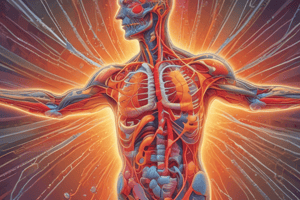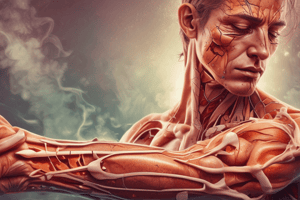Podcast
Questions and Answers
What is the result of the release of inflammatory mediators such as prostaglandins and bradykinin?
What is the result of the release of inflammatory mediators such as prostaglandins and bradykinin?
- No effect on nociceptors
- Decreased sensitivity of nociceptors to noxious stimuli
- Increased sensitivity of nociceptors to noxious stimuli (correct)
- Stimulation of low-threshold mechanoreceptors
What is the term for hypersensitivity to a noxious stimulus?
What is the term for hypersensitivity to a noxious stimulus?
- Hyperalgesia (correct)
- Allodynia
- Analgesia
- Hypoalgesia
What is the result of the stimulation of low-threshold mechanoreceptors and thermoreceptors?
What is the result of the stimulation of low-threshold mechanoreceptors and thermoreceptors?
- Allodynia (correct)
- Hypoalgesia
- Hyperalgesia
- Analgesia
What is the mechanism of action of NSAIDs in reducing pain?
What is the mechanism of action of NSAIDs in reducing pain?
What is the term for pain that results from a non-noxious stimulus?
What is the term for pain that results from a non-noxious stimulus?
What is the outcome of sensitization in the pain pathway?
What is the outcome of sensitization in the pain pathway?
Which type of receptors are involved in allodynia?
Which type of receptors are involved in allodynia?
What is the role of prostaglandins in pain perception?
What is the role of prostaglandins in pain perception?
How do NSAIDs reduce pain?
How do NSAIDs reduce pain?
What is the effect of tissue damage on nocipetors?
What is the effect of tissue damage on nocipetors?
Flashcards are hidden until you start studying
Study Notes
Inflammatory Pain
- Tissue damage releases inflammatory mediators, including prostaglandins and bradykinin
- These mediators increase the sensitivity of nociceptors to noxious stimuli, causing sensitization in the pain pathway
Effects of Inflammatory Mediators
- Sensitization leads to hyperalgesia, where there is hypersensitivity to noxious stimuli
- Allodynia occurs, where pain is felt in response to non-noxious stimuli
- Low-threshold mechanoreceptors and thermoreceptors are activated
Management of Inflammatory Pain
- NSAIDs (non-steroidal anti-inflammatory drugs) reduce the production of prostaglandins, alleviating pain
Inflammatory Pain
- Tissue damage releases inflammatory mediators, including prostaglandins and bradykinin
- These mediators increase the sensitivity of nociceptors to noxious stimuli, causing sensitization in the pain pathway
Effects of Inflammatory Mediators
- Sensitization leads to hyperalgesia, where there is hypersensitivity to noxious stimuli
- Allodynia occurs, where pain is felt in response to non-noxious stimuli
- Low-threshold mechanoreceptors and thermoreceptors are activated
Management of Inflammatory Pain
- NSAIDs (non-steroidal anti-inflammatory drugs) reduce the production of prostaglandins, alleviating pain
Studying That Suits You
Use AI to generate personalized quizzes and flashcards to suit your learning preferences.




